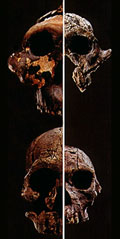The Physical Characteristics of Humans
- Page 17 -
Sexual Dimorphism
In many species, the two sexes differ significantly in form, coloration, or size. In some primate species, gorillas, for example, males are much larger and bulkier than females. In some species, males are roughly twice the size of females.
|
|
This was the case also in the earliest hominid species. Sexual difference or dimorphism is expressed in terms of a large size differential between males and females as great as it is in gorillas.
On the right are thigh bones (femurs) of adult A. afarensis (3.5 million years old); the larger bones are male and the smaller female. At left, we see contrasted the skulls of male and female A. robustus (top) and early human (bottom) from approximately 2 million years ago.
|
|
In living mammal species, size differentials of this scale are usually associated with male competition for mating privileges with "harems" of females – for example, in lions, gorillas, and sea lions. Thus, this size differential may give us clues about the social behavior of early hominids, but it is extremely “indirect” evidence. The absence of fighting canines in hominid species points in a different direction, however. It’s unlikely that much direct evidence about social behavior survives in the fossil record.
So, we look to anatomy for clues about social behavior. Interestingly, this huge size differential between males and females disappears in the human line roughly a million years ago, in Homo erectus and related species in Europe. Does this change in anatomy reflect changes in behavior?



